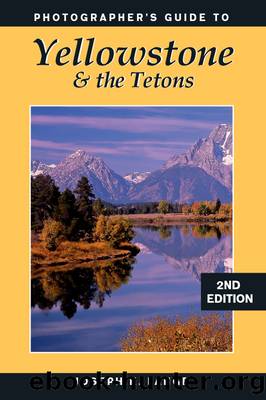Photographer's Guide to Yellowstone & the Tetons (9780811743518) by Lange Joseph K

Author:Lange, Joseph K.
Language: eng
Format: epub
ISBN: 9780811743518
Publisher: Stackpole Books
Published: 2013-05-27T16:00:00+00:00
PHOTOGRAPHING YELLOWSTONE IN AUTUMN AND WINTER
Yellowstone offers some unique scenic possibilities in autumn and winter. Autumn brings a wide range of temperatures and changing weather conditions. Significant snowstorms can occur in September, but Indian summer often prevails, with clear skies and temperatures reaching into the seventies in the afternoon. Temperatures are near or below freezing early in the morning, however, and you need to be prepared for temperature extremes and sudden changes in weather.
The meadow grasses, which have been green during the summer, now change to gold. Other plants turn brilliant colors. Sparkling frost crystals may be found on the grasses in early morning. Thin ice forms on ponds during the cold, crisp nights.
You can find multihued underbrush just east of Mammoth on the way to Tower and along the Lewis River just south of Lewis Falls on the South Entrance Road. Colorful ferns can be found just south of Gibbon Meadow between Norris and Madison and along the Firehole Lake Loop between Madison and Old Faithful. A moderate telephoto lens or macro lens will give you good close-up shots. For the most effective close-ups, don’t include too much. Crop tightly, keep the composition simple, and focus in on the most interesting portions of the scene.
Most of Yellowstone is pine forest, and there aren’t as many trees that change color as in the Tetons. Quaking aspens, which turn gold in late September, are found in only a few limited areas of Yellowstone, primarily near Mammoth and along the main loop road between Mammoth and Tower, between Tower and Canyon, and in the Lamar Valley along the Northeast Entrance Road. Aspens, with their beautiful white trunks, make fine photographic subjects throughout the year but are especially appealing in autumn. Whereas in the Tetons aspens can be used to frame the jagged peaks, in Yellowstone they often serve as the subject. Wide-angle shots pointing up from below will show their trunks and striking foliage against the sky. With a telephoto lens, the aspens can make a contrasting center of interest in a green pine forest.
In the autumn, the ferns and underbrush in Yellowstone become very colorful. Always be on the lookout for the small patterns in nature in addition to the grand scenes. I helped nature out a bit by adding the red leaf to provide a center of interest. Tokina 90mm macro lens, enhancing filter, Fuji Velvia film.
Download
This site does not store any files on its server. We only index and link to content provided by other sites. Please contact the content providers to delete copyright contents if any and email us, we'll remove relevant links or contents immediately.
| Color | Darkroom & Processing |
| Digital Editing | Equipment |
| Flash Photography | Handbooks & Manuals |
| Lighting | Reference |
Shoot Sexy by Ryan Armbrust(17134)
Portrait Mastery in Black & White: Learn the Signature Style of a Legendary Photographer by Tim Kelly(16479)
Adobe Camera Raw For Digital Photographers Only by Rob Sheppard(16381)
Photographically Speaking: A Deeper Look at Creating Stronger Images (Eva Spring's Library) by David duChemin(16153)
Bombshells: Glamour Girls of a Lifetime by Sullivan Steve(13102)
Art Nude Photography Explained: How to Photograph and Understand Great Art Nude Images by Simon Walden(12340)
Perfect Rhythm by Jae(4617)
Pillow Thoughts by Courtney Peppernell(3384)
The Book of Joy by Dalai Lama(3212)
Good by S. Walden(2910)
The Pixar Touch by David A. Price(2737)
Fantastic Beasts: The Crimes of Grindelwald by J. K. Rowling(2540)
A Dictionary of Sociology by Unknown(2516)
Humans of New York by Brandon Stanton(2376)
Read This If You Want to Take Great Photographs by Carroll Henry(2299)
Stacked Decks by The Rotenberg Collection(2267)
On Photography by Susan Sontag(2128)
Photographic Guide to the Birds of Indonesia by Strange Morten;(2086)
Insomniac City by Bill Hayes(2080)
